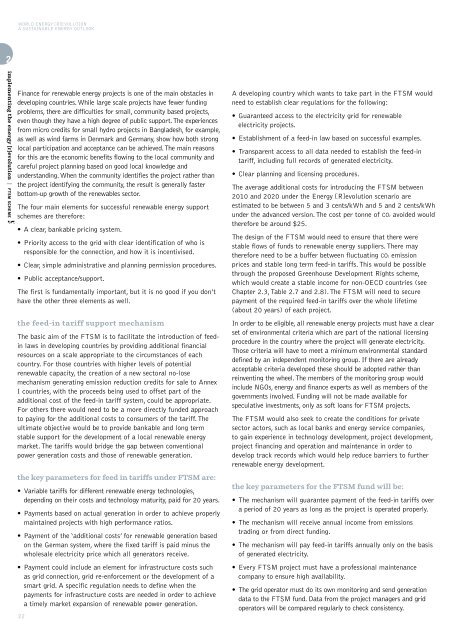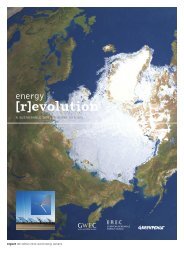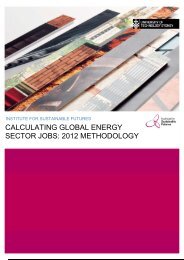download the mexico energy revolution scenario
download the mexico energy revolution scenario
download the mexico energy revolution scenario
Create successful ePaper yourself
Turn your PDF publications into a flip-book with our unique Google optimized e-Paper software.
WORLD ENERGY [R]EVOLUTION<br />
A SUSTAINABLE ENERGY OUTLOOK<br />
2<br />
implementing <strong>the</strong> <strong>energy</strong> [r]evolution | FTSM SCHEME<br />
Finance for renewable <strong>energy</strong> projects is one of <strong>the</strong> main obstacles in<br />
developing countries. While large scale projects have fewer funding<br />
problems, <strong>the</strong>re are difficulties for small, community based projects,<br />
even though <strong>the</strong>y have a high degree of public support. The experiences<br />
from micro credits for small hydro projects in Bangladesh, for example,<br />
as well as wind farms in Denmark and Germany, show how both strong<br />
local participation and acceptance can be achieved. The main reasons<br />
for this are <strong>the</strong> economic benefits flowing to <strong>the</strong> local community and<br />
careful project planning based on good local knowledge and<br />
understanding. When <strong>the</strong> community identifies <strong>the</strong> project ra<strong>the</strong>r than<br />
<strong>the</strong> project identifying <strong>the</strong> community, <strong>the</strong> result is generally faster<br />
bottom-up growth of <strong>the</strong> renewables sector.<br />
The four main elements for successful renewable <strong>energy</strong> support<br />
schemes are <strong>the</strong>refore:<br />
• A clear, bankable pricing system.<br />
• Priority access to <strong>the</strong> grid with clear identification of who is<br />
responsible for <strong>the</strong> connection, and how it is incentivised.<br />
• Clear, simple administrative and planning permission procedures.<br />
• Public acceptance/support.<br />
The first is fundamentally important, but it is no good if you don’t<br />
have <strong>the</strong> o<strong>the</strong>r three elements as well.<br />
<strong>the</strong> feed-in tariff support mechanism<br />
The basic aim of <strong>the</strong> FTSM is to facilitate <strong>the</strong> introduction of feedin<br />
laws in developing countries by providing additional financial<br />
resources on a scale appropriate to <strong>the</strong> circumstances of each<br />
country. For those countries with higher levels of potential<br />
renewable capacity, <strong>the</strong> creation of a new sectoral no-lose<br />
mechanism generating emission reduction credits for sale to Annex<br />
I countries, with <strong>the</strong> proceeds being used to offset part of <strong>the</strong><br />
additional cost of <strong>the</strong> feed-in tariff system, could be appropriate.<br />
For o<strong>the</strong>rs <strong>the</strong>re would need to be a more directly funded approach<br />
to paying for <strong>the</strong> additional costs to consumers of <strong>the</strong> tariff. The<br />
ultimate objective would be to provide bankable and long term<br />
stable support for <strong>the</strong> development of a local renewable <strong>energy</strong><br />
market. The tariffs would bridge <strong>the</strong> gap between conventional<br />
power generation costs and those of renewable generation.<br />
<strong>the</strong> key parameters for feed in tariffs under FTSM are:<br />
• Variable tariffs for different renewable <strong>energy</strong> technologies,<br />
depending on <strong>the</strong>ir costs and technology maturity, paid for 20 years.<br />
• Payments based on actual generation in order to achieve properly<br />
maintained projects with high performance ratios.<br />
• Payment of <strong>the</strong> ‘additional costs’ for renewable generation based<br />
on <strong>the</strong> German system, where <strong>the</strong> fixed tariff is paid minus <strong>the</strong><br />
wholesale electricity price which all generators receive.<br />
• Payment could include an element for infrastructure costs such<br />
as grid connection, grid re-enforcement or <strong>the</strong> development of a<br />
smart grid. A specific regulation needs to define when <strong>the</strong><br />
payments for infrastructure costs are needed in order to achieve<br />
a timely market expansion of renewable power generation.<br />
22<br />
A developing country which wants to take part in <strong>the</strong> FTSM would<br />
need to establish clear regulations for <strong>the</strong> following:<br />
• Guaranteed access to <strong>the</strong> electricity grid for renewable<br />
electricity projects.<br />
• Establishment of a feed-in law based on successful examples.<br />
• Transparent access to all data needed to establish <strong>the</strong> feed-in<br />
tariff, including full records of generated electricity.<br />
• Clear planning and licensing procedures.<br />
The average additional costs for introducing <strong>the</strong> FTSM between<br />
2010 and 2020 under <strong>the</strong> Energy [R]evolution <strong>scenario</strong> are<br />
estimated to be between 5 and 3 cents/kWh and 5 and 2 cents/kWh<br />
under <strong>the</strong> advanced version. The cost per tonne of CO2 avoided would<br />
<strong>the</strong>refore be around $25.<br />
The design of <strong>the</strong> FTSM would need to ensure that <strong>the</strong>re were<br />
stable flows of funds to renewable <strong>energy</strong> suppliers. There may<br />
<strong>the</strong>refore need to be a buffer between fluctuating CO2 emission<br />
prices and stable long term feed-in tariffs. This would be possible<br />
through <strong>the</strong> proposed Greenhouse Development Rights scheme,<br />
which would create a stable income for non-OECD countries (see<br />
Chapter 2.3, Table 2.7 and 2.8). The FTSM will need to secure<br />
payment of <strong>the</strong> required feed-in tariffs over <strong>the</strong> whole lifetime<br />
(about 20 years) of each project.<br />
In order to be eligible, all renewable <strong>energy</strong> projects must have a clear<br />
set of environmental criteria which are part of <strong>the</strong> national licensing<br />
procedure in <strong>the</strong> country where <strong>the</strong> project will generate electricity.<br />
Those criteria will have to meet a minimum environmental standard<br />
defined by an independent monitoring group. If <strong>the</strong>re are already<br />
acceptable criteria developed <strong>the</strong>se should be adopted ra<strong>the</strong>r than<br />
reinventing <strong>the</strong> wheel. The members of <strong>the</strong> monitoring group would<br />
include NGOs, <strong>energy</strong> and finance experts as well as members of <strong>the</strong><br />
governments involved. Funding will not be made available for<br />
speculative investments, only as soft loans for FTSM projects.<br />
The FTSM would also seek to create <strong>the</strong> conditions for private<br />
sector actors, such as local banks and <strong>energy</strong> service companies,<br />
to gain experience in technology development, project development,<br />
project financing and operation and maintenance in order to<br />
develop track records which would help reduce barriers to fur<strong>the</strong>r<br />
renewable <strong>energy</strong> development.<br />
<strong>the</strong> key parameters for <strong>the</strong> FTSM fund will be:<br />
• The mechanism will guarantee payment of <strong>the</strong> feed-in tariffs over<br />
a period of 20 years as long as <strong>the</strong> project is operated properly.<br />
• The mechanism will receive annual income from emissions<br />
trading or from direct funding.<br />
• The mechanism will pay feed-in tariffs annually only on <strong>the</strong> basis<br />
of generated electricity.<br />
• Every FTSM project must have a professional maintenance<br />
company to ensure high availability.<br />
• The grid operator must do its own monitoring and send generation<br />
data to <strong>the</strong> FTSM fund. Data from <strong>the</strong> project managers and grid<br />
operators will be compared regularly to check consistency.



![Energy [R]evolution - European Commission](https://img.yumpu.com/49109324/1/184x260/energy-revolution-european-commission.jpg?quality=85)


![5905 gp [eu rev]csfr4.qxd - Energy [R]evolution](https://img.yumpu.com/42305023/1/184x260/5905-gp-eu-revcsfr4qxd-energy-revolution.jpg?quality=85)


![5905 gp [eu rev]csfr4.qxd - Energy [R]evolution](https://img.yumpu.com/28729264/1/184x260/5905-gp-eu-revcsfr4qxd-energy-revolution.jpg?quality=85)